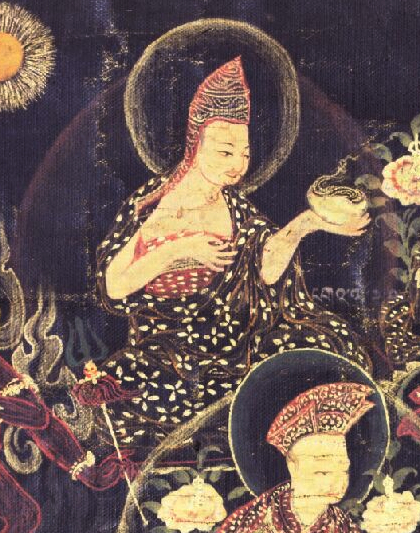During the Second Propagation of Buddhism in Tibet around the 11th and 12th centuries, new scriptures and new ritual technologies were brought over the high Himalaya by scores of Tibetans, Indian, and Nepali masters to a Tibetan Plateau politically divided into small kingdoms and powerful clans which provided patronage for religious work. The influx of the new religious material created a vibrant era of competition and exchange, and the foundations for the New Translation traditions such as the Kagyu, Geluk, Sakya, and their many subdivisions. The accounts of heroic translators such as Marpa Lotsawa (c.1012-1097) and Orgyenpa (c.1229-1309), who braved astounding dangers to travel across the mountains into wildly unfamiliar lands, are fairly well known, and their stories are still celebrated as examples of courageous compassion. The Treasury of Lives collects biographies of many other translators whose stories are no less examples of courageous quests in the name of the dharma. Two such translators are Ngok Lotsawa Loden Sherab and Ga Lotsawa Zhonnu Pel.
Ngok Loden Sherab was born in Lokha in 1059 into the Ngok clan. His uncle and main teacher, Ngok Lotsawa Lekpai Sherab (1059–1109), who had been a disciple of Atisha (c.982–1054), founded Sangpu Neutok Monastery, an early Kadam institution. In 1076, the year he was ordained, he attended the important Fire Dragon Religious Conference, which was attended by many of the Tibetan and Indian translators active at the time. The purpose of the meeting, sponsored by King Tsede of the Guge kingdom, was to encourage new and more accurate translation. Loden Sherab was chosen to join a group of young men sent to India to study language. The controversial translator Ra Lotsawa Dorje Drakpa (c.1016–c.1128) was among his five comrades on the journey; Ra Lotsawa would later murder another of their companions.
In Kashmir Ngok Loden Sherab worked closely with a scholar named Bhavyaraja who had attended the 1076 conference but was probably not a Buddhist. This did not matter too much, as most of the work they did together in Kashmir was on logic treatises. Back in Tibet he translated more than one hundred and thirty-seven thousand verses, and trained countless students in philosophy, logic, and yoga practice. In his last words he reminded them of the impermanence of the body, which might seem sturdy as a mountain but is in fact as easily burst as a bubble, and urged them to study the Three Baskets of Buddha’s words, the Tripitaka.
A near contemporary of Ngok Loden Sherab was Ga Lotsawa Zhonnu Pel (not to be confused with Go Lotsawa Zhonnu Pel, the author of the Blue Annals, who lived three centuries later). Zhonnu Pel was born and ordained in Amdo but studied Sanskrit and other Buddhist topics in central Tibet at several Kadam monasteries. He went to India to further his studies, and there met the Tangut lama Tsami Lotsawa Sanggye Drak, the abbot of the monastery at Bodh Gaya, and the Indian pandit Abhayakara (c.1104–c.1125), whom Tibetan historians incorrectly remember as a Tibetan. Zhonnu Pel is said to have initially refused to study with Tsami Lotsawa, reasoning that as he had come all the way to India he ought to study with an Indian.
Zhonnu Pel is credited with practicing in the famous Cool Grove cemetery outside of Bodhgaya, where he subjugated a form of Mahakala named the “Raven-Faced Dharma Protector,” binding him into service as a Buddhist protector. Back in Tibet he became famous for propagating the worship of this deity. He spent about six years practicing at Namtso Lake, where a young Lama Zhang Yudrakpa (1123–1193) encountered him and received his teachings. “If you become my follower, you will starve to death,” Ga Lotsawa told the young lama. “Meditate on the union of emptiness and compassion.” He then gave Lama Zhang some soup to drink that contained cumin and brown sugar, and said, “My instructions have no mouth, eyes, or ears. There is no harm now.”
Lama Zhang interpreted the offering of soup and cryptic words to mean 1) he must be willing to die for the dharma; 2) Ga Lotsawa was giving him the core of his teachings; 3) Ga Lotsawa was transmitting to him his experiences; 4) it is not appropriate to teach others if one is not liberated; and 5) if one is realized, there is no harm in teaching others.
Ga Lotsawa gave Lama Zhang many instructions and initiations that are at the core of the Kagyu tradition, including the Six Yogas of Naropa, Cakrasamvara, Kalacakra, and the Mahakala rituals. He also told Zhang to stop being a vegetarian and to eat bones and meat, at least until his headaches went away. In addition to teaching Lama Zhang, Ga Lotsawa also taught the Six Yogas of Naropa to Pakmodrupa Dorje Gyelpo (1110–1170) and to the First Karmapa, Dusum Khyenpa (1110–1193).
Ga Lotsawa is credited with translating eight works in the Tengyur, the collected translations of the Indian commentaries to Buddhist scriptures.
Biography and autobiography in Tibet are important sources for both education and inspiration. Tibetans have kept such meticulous records of their teachers that thousands of names are known and discussed in a wide range of biographical material. All these names, all these lives—it can be a little overwhelming. The authors involved in the Treasury of Lives are currently mining the primary sources to provide English-language biographies of every known religious teacher from Tibet and the Himalaya, all of which are organized for easy searching and browsing.
Thank you for subscribing to Tricycle! As a nonprofit, we depend on readers like you to keep Buddhist teachings and practices widely available.
